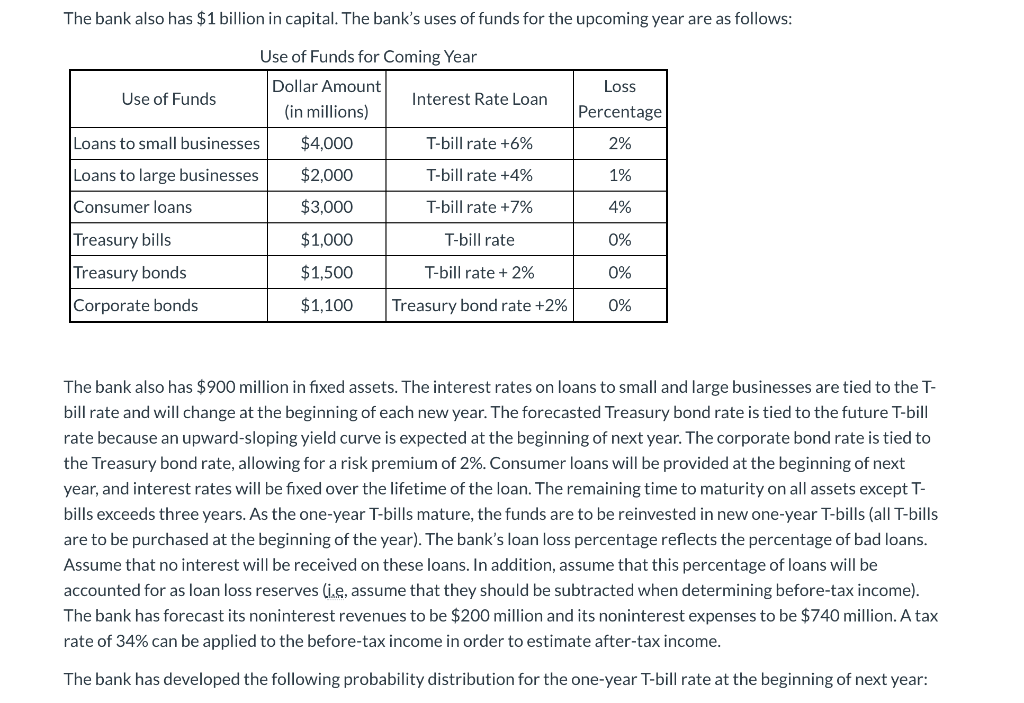


Read the integrative problem below and respond to the following: Identify the probability distribution of return on assets (ROA) for next year by completing this table: Predicted Return on Assets Based on Interest Rate Interest Rate Scenario (Possible T-Bill Rate) Predicted ROA Probability 6% 7% 8% Next year, will the bank's ROA be lower or higher, if market interest rates decline? Support your decision. Note: You can use the T-bill rate to represent market interest rates. INTEGRATIVE PROBLEM: As an analyst of a medium-sized commercial bank, you have been asked to forecast next year's performance. In June, you were provided with information about the sources and uses of funds for the upcoming year. The bank's sources of funds for the upcoming year are as follows (where NCDs are negotiable certificates of deposit): Source of Funds for Coming Year Source of Funds Dollar Amount (in millions) Interest Rate to be Offered Deman Deposits $5,000 0% Time Deposits $2,000 6% 1-year NCD's $3,000 T-Bill rate + 1% 5-year NCD's $2,500 1-year NCD rate + 1% The bank also has $1 billion in capital. The bank's uses of funds for the upcoming year are as follows: Loss Percentage 2% Use of Funds for Coming Year Dollar Amount Use of Funds Interest Rate Loan (in millions) Loans to small businesses $4,000 T-bill rate +6% Loans to large businesses $2,000 T-bill rate +4% Consumer loans $3,000 T-bill rate +7% Treasury bills $1,000 T-bill rate Treasury bonds $1,500 T-bill rate + 2% Corporate bonds $1,100 Treasury bond rate +2% Treasury bond rat 1% 4% 0% 0% 0% The bank also has $900 million in fixed assets. The interest rates on loans to small and large businesses are tied to the T- bill rate and will change at the beginning of each new year. The forecasted Treasury bond rate is tied to the future T-bill rate because an upward-sloping yield curve is expected at the beginning of next year. The corporate bond rate is tied to the Treasury bond rate, allowing for a risk premium of 2%. Consumer loans will be provided at the beginning of next year, and interest rates will be fixed over the lifetime of the loan. The remaining time to maturity on all assets except T- bills exceeds three years. As the one-year T-bills mature, the funds are to be reinvested in new one-year T-bills (all T-bills are to be purchased at the beginning of the year). The bank's loan loss percentage reflects the percentage of bad loans. Assume that no interest will be received on these loans. In addition, assume that this percentage of loans will be accounted for as loan loss reserves (ie, assume that they should be subtracted when determining before-tax income). The bank has forecast its noninterest revenues to be $200 million and its noninterest expenses to be $740 million. A tax rate of 34% can be applied to the before-tax income in order to estimate after-tax income. The bank has developed the following probability distribution for the one-year T-bill rate at the beginning of next year: The bank has developed the following probability distribution for the one-year T-bill rate at the beginning of next year: Probability Distribution for one year T-bill at the beginning of next year Possible T-Bill Rate | Probability 6% 20% 7% 60% 8% 20% Read the integrative problem below and respond to the following: Identify the probability distribution of return on assets (ROA) for next year by completing this table: Predicted Return on Assets Based on Interest Rate Interest Rate Scenario (Possible T-Bill Rate) Predicted ROA Probability 6% 7% 8% Next year, will the bank's ROA be lower or higher, if market interest rates decline? Support your decision. Note: You can use the T-bill rate to represent market interest rates. INTEGRATIVE PROBLEM: As an analyst of a medium-sized commercial bank, you have been asked to forecast next year's performance. In June, you were provided with information about the sources and uses of funds for the upcoming year. The bank's sources of funds for the upcoming year are as follows (where NCDs are negotiable certificates of deposit): Source of Funds for Coming Year Source of Funds Dollar Amount (in millions) Interest Rate to be Offered Deman Deposits $5,000 0% Time Deposits $2,000 6% 1-year NCD's $3,000 T-Bill rate + 1% 5-year NCD's $2,500 1-year NCD rate + 1% The bank also has $1 billion in capital. The bank's uses of funds for the upcoming year are as follows: Loss Percentage 2% Use of Funds for Coming Year Dollar Amount Use of Funds Interest Rate Loan (in millions) Loans to small businesses $4,000 T-bill rate +6% Loans to large businesses $2,000 T-bill rate +4% Consumer loans $3,000 T-bill rate +7% Treasury bills $1,000 T-bill rate Treasury bonds $1,500 T-bill rate + 2% Corporate bonds $1,100 Treasury bond rate +2% Treasury bond rat 1% 4% 0% 0% 0% The bank also has $900 million in fixed assets. The interest rates on loans to small and large businesses are tied to the T- bill rate and will change at the beginning of each new year. The forecasted Treasury bond rate is tied to the future T-bill rate because an upward-sloping yield curve is expected at the beginning of next year. The corporate bond rate is tied to the Treasury bond rate, allowing for a risk premium of 2%. Consumer loans will be provided at the beginning of next year, and interest rates will be fixed over the lifetime of the loan. The remaining time to maturity on all assets except T- bills exceeds three years. As the one-year T-bills mature, the funds are to be reinvested in new one-year T-bills (all T-bills are to be purchased at the beginning of the year). The bank's loan loss percentage reflects the percentage of bad loans. Assume that no interest will be received on these loans. In addition, assume that this percentage of loans will be accounted for as loan loss reserves (ie, assume that they should be subtracted when determining before-tax income). The bank has forecast its noninterest revenues to be $200 million and its noninterest expenses to be $740 million. A tax rate of 34% can be applied to the before-tax income in order to estimate after-tax income. The bank has developed the following probability distribution for the one-year T-bill rate at the beginning of next year: The bank has developed the following probability distribution for the one-year T-bill rate at the beginning of next year: Probability Distribution for one year T-bill at the beginning of next year Possible T-Bill Rate | Probability 6% 20% 7% 60% 8% 20%









